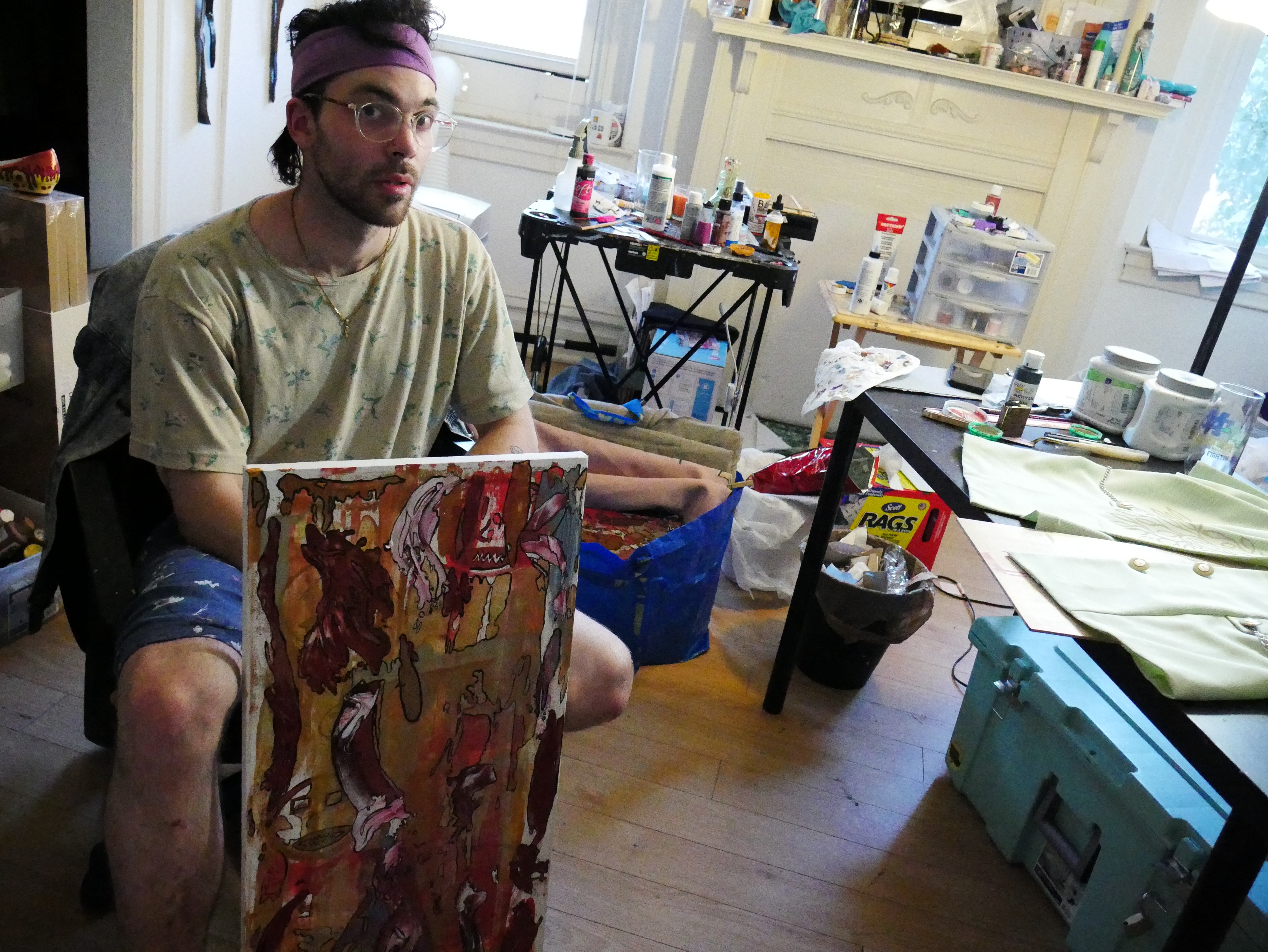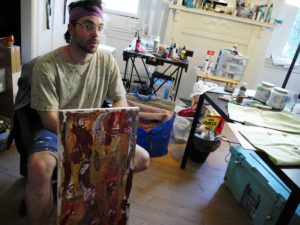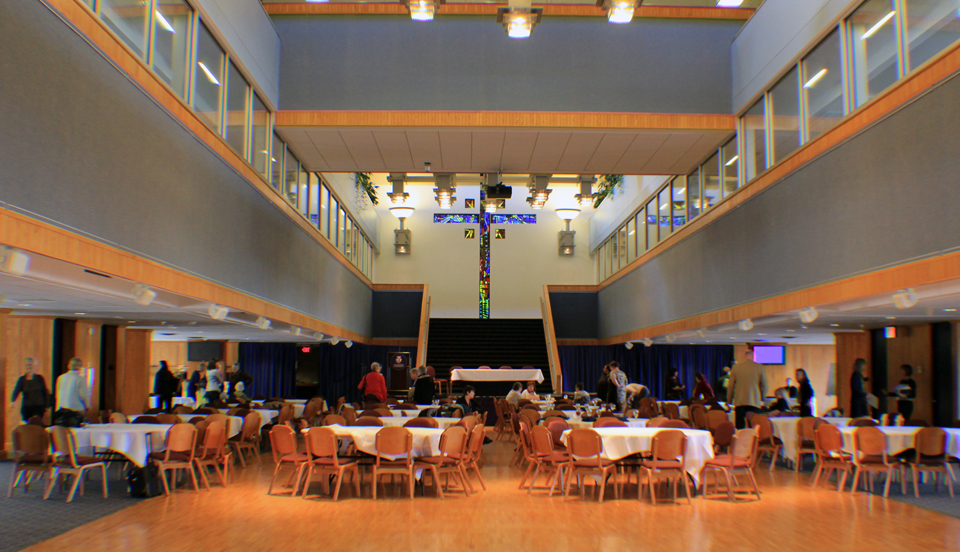

Frick poses in their studio with a piece that will be on display in the gallery.
Sean Armstrong | Staff Writer
09/04/19
Stew Frick, a fashion designer and painter, sees the arts as a well to draw from when dealing with mental illness, the confining nature of gender stereotypes and community. Their first solo gallery and fashion release, Worse For Wear, will appear on Friday, Sept. 6 at BOOM Concepts in Bloomfield.
That last source of inspiration — community — is why Frick chose BOOM Concepts for their first independent showing.
“There’s a lot of places that I have enjoyed art and enjoyed the art that was created there but BOOM [Concepts] takes it to another level by putting so much effort into the functional aspects of being an artist. One of their main hallmarks is ‘we get artists paid.’”
BOOM Concepts, the home of Jenesis Magazine and numerous artistic events like the Pittsburgh Comics Salon’s Artist Talk, is a pillar for the community in the Pittsburgh art scene. Frick, someone conscious about power structures and how those interplay with community, understands the need for spaces like this.
“I think that an arts community and the way it’s organized and the people that are elevated within it is intrinsically important to the social ecosystem of whatever space they’re occupying, In this case a city,” Frick said. “I think the Pittsburgh artistic community is inherently important to what Pittsburgh is and how it operates.”
Frick explained what drives their desire to support this local scene.
“I like to think that I am a good person with good morals and ideals and who tries to support other people with good morals and ideals,” Frick said. “And thus being able to express myself within the scene that I’ve been inspired by allows me to both raise up the ideals that I live by [and] platform other people that have those same ideals and I think that’s inherently important to living in any kind of community.”
While it is important to understand that Frick values the art community because there are many likeminded individuals within this group, Frick also thinks people need to play their roles in the community not just regurgitate each other’s ideas.
“[Mental health] feels like something that I actually have something to say about that I’m not just parodying or re-expressing other people’s ideas on,” Frick said. “One of my biggest fears in art is just repackaging others’ ideas whenever I could simply support other people that are already expressing those ideas. This is one of the only things that I feel is completely unique to myself.”
This fear is what drives Frick to design fashion and paint images of their experiences with synesthesia, psychotic depression and schizophrenia. In past fashion collections and paintings, Frick often painted a jaw they would see whenever they were having a psychotic episode. This jaw would serve as the centerpiece to their first fashion line, the Sweet Tooth Collection.
Now, nearly two years after that first fashion line, Frick has set their sights a little higher. Rather than focus on the lesser-known mental conditions, synesthesia and psychotic depression, Frick wants to talk about the well-known, socially stigmatized condition of schizophrenia.
According to the American Psychological Association, schizophrenia is described as, “a serious mental illness characterized by incoherent or illogical thoughts, bizarre behavior and speech and delusions or hallucinations, such as hearing voices. Schizophrenia typically begins in early adulthood.”
To fully grasp the extent to which it can debilitate a person the World Health Organization [WHO] states that, “People with schizophrenia are two to three times more likely to die early than the general population. This is often due to physical illnesses, such as cardiovascular, metabolic and infectious diseases.”
Still, as chronic a mental illness as schizophrenia is, according to the WHO, about 23 million people have schizophrenia worldwide.
“There are things more important than the show I’m making, but I think that there are other people better equipped to talk about that than I am,” Frick said.
“It sort of feels like winning in the end. Because I mean, schizophrenia can feel very adversarial with yourself,” Frick said. “At least, especially in my case, I found it to be very adversarial. It’s yourself trying to destroy yourself. So, having the opportunity to turn that around and essentially twist the thing that was trying to destroy you into building you up instead is kind of a slap in the face to my own demons.”
This cognitive reinterpretation of mental illness through the act of profiting off of mental illness is why Frick calls their show a “selfish” one despite some of the underlying, altruistic intentions.
“Maybe it’s just my own grandiose thinking and self-image that leads me to feel like explaining psychosis is so important but it feels like a life or death thing of explaining how important it is. There’s levels to this that I can’t possibly explain. There’s levels to the fear, the mental state, the experience, the intricacies of everything that aren’t explainable through a painting or through a piece of clothing or through your writing or through words. I think it’s important people understand how difficult that stuff is.”
“What I hope people can take away is at least in some part empathy for people who deal with psychosis. I’m really lucky in this regard. I have a lot of privilege. I had a lot of support systems. I had a lot of access to mental health care that people do not have. A lot of the reason that I am able to be as healthy as I am now is simply because my family had good health insurance. I got treatment five months into having psychotic symptoms and if I didn’t have that I would probably be dead. I was operating on a pretty short-thin string towards the end and most people that deal with the same symptoms and same conditions as I do, as I did and do, don’t have the same resources. [They] don’t have the platform to have an art show extolling their hallucinations and their fears.”




